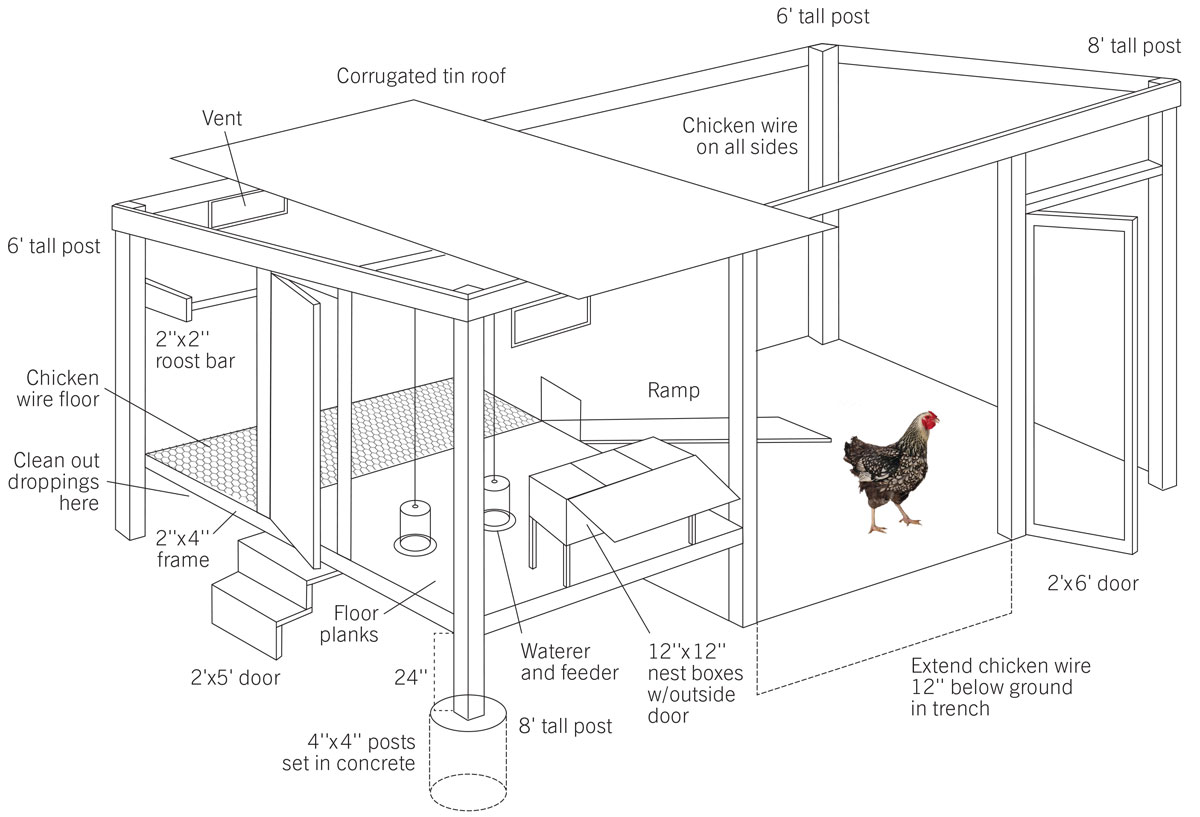Design of low-cost greenhouse chicken house construction of rural household chicken house
Building a basic chicken coop for a small group of birds is a solid weekend project, preparing for a firm do-it-yourself with basic carpentry skills, while a more sophisticated chicken coop can take weeks (and require advanced carpentry skills).
The Internet is full of plans for backyard chicken sheds, which are a good place to look for inspiration, but all henhouses have two main components: an enclosed space for sleeping and laying eggs, and an open-air "flock of chickens" that can roam around. That day. The enclosed space should lead directly to the operation, but should be at least two feet above it, so that there is room to collect feces that fall on the floor. (it will be described in more detail later. There are many possible ways to configure a chicken coop, but here is how to build a basic model that can be easily customized to your aesthetic taste.
Step 1: plan the size and location
The first thing to consider is size. The minimum acceptable size is 2 to 3 square feet per chicken in the henhouse and 4 to 5 square feet per chicken. However, extra space is always better-just like humans, chickens are prone to quarrels when they are squeezed into narrow places at any time.
Chickens only need shade in hot weather, so it is ideal to put the henhouse under a large deciduous tree-they are cool in summer and can bask in the sun in winter once the leaves fall. If there is no ground under the trees, the runway must be covered with a sunshade.
Step 2: build the framework
As with most ancillary buildings, the easiest way is to start with a rectangular frame and then add the various components you need. Use naturally decaying wood-such as cedar or mahogany-instead of pressure-treated wood containing heavy metals such as arsenic, which can be harmful to the health of chickens. Open-air operation should be covered with chicken wire (metal mesh) to prevent predators from entering.

1. Depending on the size of the henhouse you want (for example, 4 feet by 8 feet or 6 feet by 12 feet or 8 by 16 feet), set up four 4 × 4 posts in concrete in a rectangular shape. Cut the post to a height of 8 feet at the front and 6 feet at the back to install a sloping roof on the enclosed part.
two。 Add a 4 × 4 column 2 feet to the right front corner of the rectangle. The purpose of this article is to support a door, which should be 8 feet high as the entrance to the runway.
3. Nail 2 or 4 screws horizontally between the above pillars in the front right corner of the 6-foot runway.
4. Use 2 × 2 wood to build a door frame to accommodate the space of the entrance passage (a 2 × 6-foot rectangle). This only requires a 2 × 2s rectangular screw or nailed together. Use the anti-sag gate kit to prevent the 2 × 2 frame from sagging. Use galvanized door hinges to install the door frame on the corner post.
5. Add a pair of parallel 4 × 4 columns, which is about 1/3 of the distance to the left of the rectangle. (for example, if the henhouse is 12 feet wide, the pillars are 4 feet from the posts on the left corner. These columns are used to support the frame of the enclosed part of the chicken house. They should correspond to the heights of other front and rear columns.
6. Install a horizontal 2 × 4s frame between the tops of all pillars along the front and rear sides of the structure, and add three rafters at an angle between three pairs of higher front pillars and shorter rear pillars.
7. Connect a horizontal 2 × 4 frame to four columns more than 24 inches on the left side of the rectangle. These will support the floor of the enclosed area.
8. At the first 2/3 of the structure, add a floor to the top of the 2 × 4 frame and connect it with galvanized nails or decorative screws.
9. Cover 1/3 of the floor with shredded chicken. Chickens will perch above this part of the floor, and hard cloth will allow faeces to pass through, so they can be collected from below.
10. Dig a 12-inch groove around the runway.
11. At 2/3 on the right side of the rectangle, stretch the chicken wire between the columns (as walls) and the columns in the running area between the horizontal (as ceilings), and connect them to the wooden frame using poultry nails. Install shredded chicken into the bottom of the trench to prevent digging animals and refilling the trench with soil
To secure it in place. Cover the door frame with shredded chicken. Because of the sharp edges, wear gloves when using shredded chicken.
Step 3: equipment interior decoration
The interior of the operation only needs to lay a thick layer of straw on the ground to absorb chicken manure and water when it rains. You can also hang a watering device from one of the rafters (through the fishing wire attached to the nails) so that they can drink water when they are outside during the day. (the base of the drinking fountain should be 6 to 8 inches above the ground. ) if there is no shelter when running at the hottest time of the day, add a sunshade to the top of the shredded chicken ceiling. Build a gentle ramp at least 8 inches wide on the platform above the ground to the enclosed area. Before this area is closed, please equip with the following items:
Lay a 2 × 2 wood perch along the back wall on the shredded chicken floor (each bird is at least 8 inches long)
Nest box (at least one 12-inch square box for every 4 birds)
A watering device and a feeder (hanging them and the floor attached to the nail swabbing line chicken house is mashed into a roof rafter more than 6 to 8 inches)
Incandescent bulbs that extend the laying season (optional)
Follow the front wall to find the nest box at least 24 inches from the floor. These can be as simple as wooden shelves, and plywood separators are full of straw. Add a 2-inch piece of wood to the front of the box to prevent the straw from overflowing. There are also prefabricated nest boxes, but some chicken breeders use plastic litter boxes as nests because they are easy to clean and clean periodically. The location of the habitat should be higher than the nest. Chickens are descended from arboreal jungle chickens and always look for the highest point to sleep (if chickens use them for habitat, the nest will quickly become dirty).
Step 4: complete the external
It is time to add roofs and walls to seal off nesting and habitat areas. Any weatherproof material can be used, but tin is a simple and stylish choice for roofs, and wooden panels provide a quaint look for the walls. (additional 2 x 4 frames are required for wall and roof structures. When you build walls, be sure to plan to make it easy to collect eggs and clean chicken coops. All access points should be locked with anti-raccoon locks-a typical latch with a climbing buckle in the screws is usually enough to cover these masked bandits.
Planned three-way visit:
A 12 x 12-inch door with a ramp entering from the runway.
There is a 12 x 12 inch hatch in the front wall, which can be collected into the nest.
There is a 2 x 5-foot door on the left wall that can enter the water and feeder and clean the chicken coop.
The three types of inspection doors can be constructed with a simple 2 × 2 frame in the same way as the main entrance door that the chicken runs. Instead of covering them with shredded chicken, use the same material as the outside of the chicken coop. (in this case, an anti-sinking kit is not required. )
Ventilation is very important in summer. The chicken door and the wire-netted floor will allow air to enter from below, but there will also be a place where hot air will be discharged from the top. Either leave a space between the eaves of the roof and the top of the wall, or cut the vents near the top of the wall. In either case, make sure these spaces are covered with shredded chicken to prevent the emergence of organisms.
This is the basics of functional collaboration, but you can customize it and beautify it in any way you like. Gorgeous decoration, ornate gadgets and colorful works of art are all the standards of chicken house decoration in the world.
- Prev

Rainbow Trout Culture Base in Nanmei Village, Linxiang District, Lincang District, Yunnan Province
According to the overall arrangement and arrangement of the district party committee and government on the poverty alleviation and whole township promotion project of Nanmei Township, in order to build Nanmei Township into a model of beautiful village and realize the goal of village beauty, people's wealth and people's happiness, Linxiang District Agricultural Bureau combined with reality, in accordance with the requirements of special cultivation, relying on
- Next

What should we pay attention to in raising rabbits? Introduction to the breeding techniques and methods of rabbits
Do you know how to raise rabbits? What aspects should be paid attention to when breeding? How to raise a good rabbit? let's have a look. Rabbit feeding method 1. The living habits of rabbits are similar to those of mice in quiet days and good food at night. Quietly during the day
Related
- On the eggshell is a badge full of pride. British Poultry Egg Market and Consumer observation
- British study: 72% of Britons are willing to buy native eggs raised by insects
- Guidelines for friendly egg production revised the increase of space in chicken sheds can not be forced to change feathers and lay eggs.
- Risk of delay in customs clearance Australia suspends lobster exports to China
- Pig semen-the Vector of virus Transmission (4)
- Pig semen-the Vector of virus Transmission (3)
- Five common causes of difficult control of classical swine fever in clinic and their countermeasures
- Foot-and-mouth disease is the most effective way to prevent it!
- PED is the number one killer of piglets and has to be guarded against in autumn and winter.
- What is "yellow fat pig"? Have you ever heard the pig collector talk about "yellow fat pig"?

